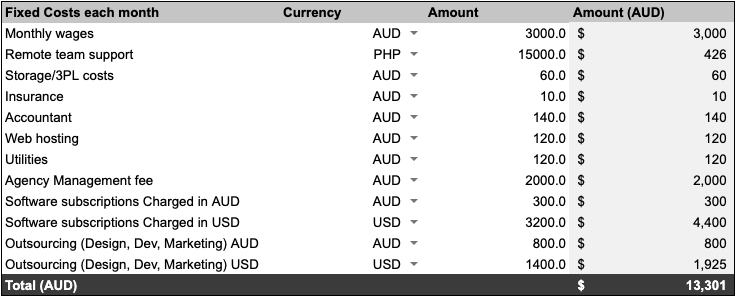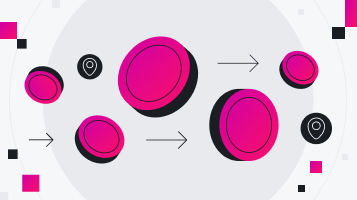Break-even analysis made easy: find your business’s break-even point

Breaking even is never the end goal of new businesses — you want to be profitable.
However, this is easier said than done.
9 out of 10 eCommerce businesses fail within the first four months. And having too little financing is one of the top six reasons that businesses fail.
With these odds in mind, it’s essential to have a plan in place to help your business break even. And that starts with performing a break-even analysis to determine your break-even point.
What is a break-even analysis?
A break-even analysis is a tool that businesses use to determine when their business will break even and start to turn a profit. It allows you to determine your total fixed business costs and how much product you need to sell (or how much income you need to make) in order to cover these expenses.
And while performing a break-even analysis is important to provide you with this break-even point, it can also be a helpful learning tool that sheds light on your business’s financials.
The importance of a break-even analysis
A break-even analysis is crucial to help eCommerce businesses set clear goals and make smarter plans.
Setting clear goals
A break-even analysis involves working with unit volumes. As such, it’s beneficial to determine the costs associated with each unit of your stock, as well as how many units you must sell to cover your operating costs.
With these details, you can craft a logical plan for pricing your products and determine whether you need to adapt your sales tactics. Then you’ll have a better idea of realistic sales targets and how much you can safely spend on acquisition to ensure profitability.
Making smarter plans
It’s hard to plan if you don’t know if a new sales avenue is going to make you a profit. A break-even analysis solves this problem.
For example, you’ll be able to determine whether it’s worthwhile to, for example, set up a short-term pop-up location or attend a sales event. And if you decide to migrate all of your Amazon sales to your own website, you’ll have peace of mind knowing that your efforts will pay off.
A break-even analysis also helps reduce potential business risk when you pursue a new business opportunity or launch a new product. What’s more, it provides you with tangible insights you can use when pitching to investors or applying for finance. You can use these insights to prove that you have a clear picture of your business’s cash flow and a plan for the future.
How to perform a break-even analysis
To calculate your break-even point based on units, divide your total fixed costs by the sale price per unit minus the variable cost per unit (margin).

But first things first — let’s take a look at how to determine your business’s fixed costs and variable costs.
What is a fixed cost?
Fixed costs are the expenses that your business must pay regularly, such as each month or year. They remain roughly the same regardless of your business’s income.
Examples of typical fixed costs include:
Rent or mortgage
Utility costs
Insurance
Product storage expenses
Software subscriptions
Another way to think of it is that fixed costs are the expenses associated with your business rather than with the stock you produce.
For those using our break-even template, add your fixed costs in the currency you're charged into the table marked Step 1, as pictured below.

What is a variable cost?
Variable costs are the individual costs that go into making or selling one unit of your stock. These costs are subject to change for various reasons.
For example, imagine that your business sells something like magnetic bottle openers painted in football team colors, which you source from Vietnam. Your costs for producing these bottle openers include:
Material costs
Labor
Packaging
Postage
Payment processing fees for international payments sent to your supplier
If you’re using our break-even template, add your variable costs to the appropriate table to find your break-even point.

How to calculate your break-even point
Now that you've determined your fixed and variable costs, it's time to calculate your break-even point in units. This is the magic number of how many units you need to sell in a given period — in this case, a month — in order to break even.
Divide your total fixed costs by your sale price minus your variable costs to find your break-even point.
Example: break-even units
You sell your magnetic bottle openers for $15 each. Sourcing, labor, packaging, posting, and everything else comes to $10 per item.
Your total fixed costs for your storage space, office rent, subscriptions to your creative tools, and your utilities come to $1,700.

Example: break-even point in sales dollars
This follows a similar process, but involves the product’s contribution margin in your calculations.
The contribution margin is the percentage of your product’s sales cost that’s left after all the product costs are paid for — so the percentage of the sales price that contributes to your profit.

How to improve your unit economics
The seemingly obvious way to lower your break-even point is to raise the prices of your products.
But it’s not that easy. Customers are sensitive to price increases. They don’t like change. This can backfire and cause a drop in your customer base.
So if this method looks like it could price you out of the market, it’s better to look at your costs instead.
1. Lower your fixed costs
You’ve mapped out all your fixed costs. Now it’s time to see if there are any costs that you can remove.
It might be looking at better-priced storage options, finding a cheaper internet provider, or seeing if you can negotiate a rent reduction. It might mean stopping spending on some aspects altogether.
Or, it can be as simple as switching from a bank account with a monthly fee to a fee-free account.
This is where Airwallex can help you out. You pay no fees on your business accounts, ever. Additionally, you can open global accounts in 11+ currencies, so you won’t have to pay international transfer fees, either. This one easy change means you can permanently reduce banking costs for your business.
It might sound small, but these costs add up quickly.
2. Lower your variable costs
Lowering your variable costs takes a little more effort.
It can include searching for suppliers who offer more competitive rates on your stock or better bulk rates. You may be able to find a production plant with cheaper labor costs, or a courier that offers better prices.
You could streamline your processes. For instance, maybe your packaging doesn’t need that added layer of wrapping. Or you might stop including bonus stickers and postcards in all your packages.
Another idea is to look at the fees you pay on your banking. For example, if you source your products internationally, you’re likely paying international transaction fees.
Airwallex’s Borderless Cards and Global Accounts help you cut out international transaction fees altogether. You’ll also receive a foreign exchange rate that’s up to 90% better than what any of the big banks can offer.
You’ll be able to lower your spending costs, fees, and break-even point all at the same time.
Airwallex is a better way to do your business banking
Now that you know the break-even point for your business, your next step is to make it more cost-effective.
Airwallex can help you lower your costs, get a better deal on international payments, and eliminate bank fees. Sign up or watch a short demo today to get started.
Related article: How to calculate and improve ROI in easy steps
Share

Evan Dunn manages the growth of Airwallex's SMB business in the US through marketing avenues. Evan is a generalist with expertise in SEO, paid media, content marketing, performance marketing and social selling. He also enjoys slam poetry and waffle making.
View this article in another region:AustraliaSingaporeGlobal
Related Posts

How to use Airwallex for automated insurance payouts
•5 minutes

Wallets, cards, and the flywheel effect: the formula for marketpl...
•6 minutes
